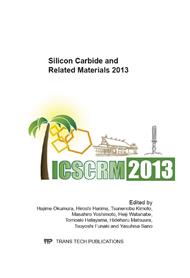p.1146
p.1150
p.1154
p.1158
p.1162
p.1166
p.1170
p.1174
p.1180
Solid Phase Growth of Graphene on Silicon Carbide by Nickel Silicidation: Graphene Formation Mechanisms
Abstract:
This work presents experimental evidence of the formation mechanisms of few-layer graphene (FLG) films on SiC by nickel silicidation. FLG is formed by annealing of a 40 nm thick Ni layer on 6H-SiC at 1035ºC for 60 s, resulting in a Ni2Si layer which may be capped by any Ni that did not react during annealing. It has been proposed that FLG forms on top of the Ni during the high temperature stage. In contrast, during cooling, carbon atoms which were released during the silicidation reaction may diffuse back towards the Ni2Si/SiC interface to form a second FLG film. After annealing, layer-by-layer de-processing was carried out in order to unequivocally identify the FLG at each location using Atomic force microscopy (AFM) and Raman spectroscopy.
Info:
Periodical:
Pages:
1162-1165
Citation:
Online since:
February 2014
Price:
Сopyright:
© 2014 Trans Tech Publications Ltd. All Rights Reserved
Share:
Citation:



